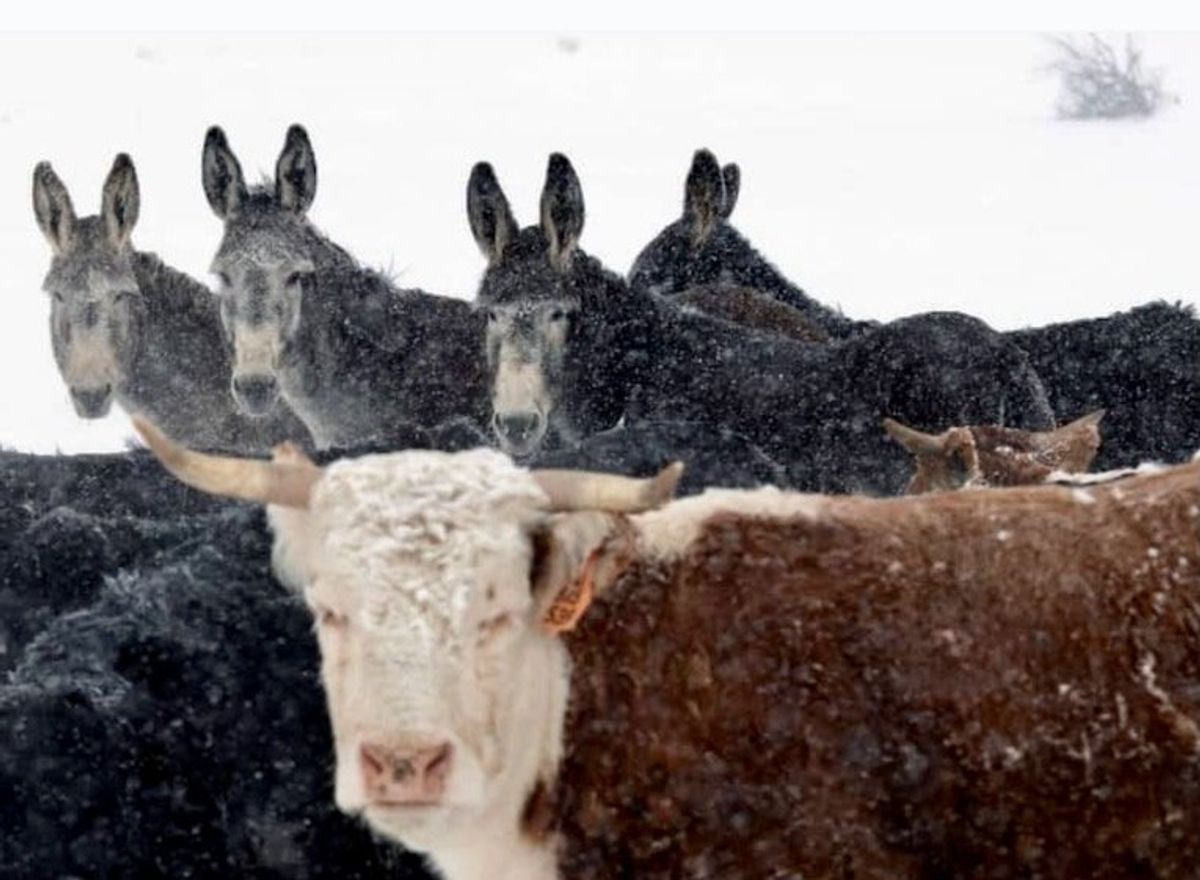The Philadelphia Inquirer/TNS
2023/04/10

2023/04/10

Supporters of John Fetterman wait at a campaign rally at the Carpenters Union Hall in Pittsburgh on Nov. 7, 2022. - Tyger Williams/The Philadelphia Inquirer/TNS
PHILADELPHIA — Pennsylvania Democrats are trying to show they can be populists, too.
When Gov. Josh Shapiro took office in January, he sent a symbolic message by using his first executive order to end the four-year college degree requirement for most state government jobs. Sen. John Fetterman campaigned as a Democrat who would fight for "forgotten communities." And as U.S. Rep. Chris Deluzio has started his first term representing a Western Pennsylvania district, he's delivered sharp criticism of "the incompetence and greed" of "big corporations" such as Norfolk Southern.
"It's about building a government that serves everyone, not just the rich and powerful," said Deluzio, a Navy veteran and Georgetown Law graduate whose congressional bio emphasizes his work helping form a union at the University of Pittsburgh.
As politics in Pennsylvania and nationally have shifted, and Republicans have gained ground with white working-class voters — epitomized by Donald Trump's crucial victory in the state in 2016 — the GOP has portrayed Democrats as the party of a snobbish elite, attacking liberals as scolds who have lost touch with everyday workers while trying to impose their views on race, gender, guns, and the environment.
"Some of it is just cultural, and the label of the Democratic Party right now just doesn't appeal to some parts of Pennsylvania that they used to appeal to really well," said Nick Trainer, a Republican strategist who worked on Trump's 2020 reelection campaign.
But Democrats argue they've always been — and remain — the true party of working people. They say their policies, including support for labor unions, expanded health-care access, and a higher minimum wage, offer tangible help for the working class while Republicans have pushed tax cuts and deregulation that benefit the wealthy and corporations.
But populism — a broad term often used to convey everyday people's attitudes and anger toward the powerful — isn't only about policy ideas. It's often about image and approach.
"We don't have to overthink it and out-policy the other folks," said Rebecca Kirszner Katz, Fetterman's longtime strategist. "We have to be smart and remind people what we stand for and how we'll fight for them. It's not that complicated, and we've just done a terrible job of explaining it."
While some on the Democratic side, including Sen. Bernie Sanders, have embraced populism, railing against financial elites, Trump channeled it most emphatically in his 2016 victory. He blended white racial grievances with raw fury at the establishments in both parties, which he said had sold out ordinary workers. It was hugely successful in some culturally conservative parts of Pennsylvania that had lost much of their industry and that finally broke with their Democratic roots.
Despite Trump's wealth and a business career catering to the upper crust, he made disaffected voters "feel seen," Katz said. "A lot of Democratic politicians were very clinical."
Democrats have tried to correct for that, nominating more plain-spoken candidates such as Fetterman and President Joe Biden. And they've used suspicion of wealthy elites in their own way, attacking last year's GOP Senate nominee in Pennsylvania, Mehmet Oz, as a rich out-of-stater, and using a similar approach against David McCormick, a former hedge-fund executive eyeing another Senate bid in 2024.
Pennsylvania has a higher than average share of voters who didn't attend college, giving much of it a blue-collar culture and worldview.
"You can't win Pennsylvania if you're not able to appeal to non-college voters," said J.J. Balaban, a Democratic strategist based in Philadelphia.
He argues Democrats have always been the party of the working class, but it's become more important to emphasize as Trump and his imitators have adopted populist rhetoric, if not policies.
"For Democrats, populism is about economics. For Republicans, it's largely about cultural grievances," Balaban said.
The Norfolk Southern train derailment near the Pennsylvania- Ohio border presents a prime target for anger at big business.
Shapiro told The Inquirer about a conversation with a woman in Beaver County, which borders East Palestine, Ohio, the site of the crash. Her family had lost several dozen eggs from their family chickens "and this was real money for them and important for their family income."
Shapiro said that when he met with Norfolk Southern's top executive, he cited that story as he pushed the railroad to provide aid.
"That kind of stuff happens when you show up, treat people with respect, listen, and then are willing to take on the powerful," Shapiro said, a theme he came back to several times in a late March interview.
Changing the state's hiring rules, he said, would expand opportunities for people who didn't attend college. It tangibly affects only a sliver of jobs, but the fact that Shapiro made that move his first official act illustrates the political imperative of showing working-class appeal.
Fetterman rarely emphasized specific policy ideas during his campaign, but his image as the tattooed mayor of a hard-hit steel town was a powerful marker. Katz said his success came down to something more fundamental.
"He talks to people like they're on the same level as him," Katz said. "One of the bigger problems with Democrats in the past is that they have spoken down to voters, and John never spoke down to anyone."
While Katz worries some Democrats are still too concerned about appealing to wealthy donors, others appear more comfortable channeling anger and frustration, even as their victories in recent elections have depended significantly on voters from affluent suburbs.
"Who we are in Western Pennsylvania, our identity, our history, is wrapped up and tied to the labor movement, and it's tied to fighting for working people," said Deluzio, whose district straddles the Pittsburgh suburbs and more blue-collar Beaver County.
His guest at his first State of the Union speech was a mailer on strike from the Pittsburgh Post-Gazette. Many voters, Deluzio said, are right to feel angry about being harmed by businesses and politicians.
"Folks were mad for a reason, one that I think is fair and valid: They saw jobs and factories ripped away," he said.
Fetterman's pledge to stand up for "forgotten communities" echoed some of the language that once helped propel Trump.
While the start of his Senate career has been stunted by a hospitalization for depression treatment, Fetterman's public statements so far have targeted "corporate greed" and accused oil companies of "disgusting" price gouging.
And Biden's approach toward reelection was on full display in his most recent visit to Philadelphia, where he told a room full of union members, "For too long, working people have been breaking their necks ... while those at the top get away with everything."
"Going after corporations and the ultrarich is overwhelmingly popular, and the fact that many Democrats don't do that is political malpractice," Katz said.
Fetterman's victory last year over Oz, for example, was driven by a devastating blitz casting Oz as a rich celebrity from New Jersey who couldn't relate to ordinary Pennsylvanians.
Democrats are already running a similar strategy against McCormick, who ran against Oz last year and is considering another campaign in 2024. They point to his immense wealth, expensive homes, and years leading a hedge fund.
"So much of the attacks that worked on Oz can also work on McCormick," Katz said.
McCormick has countered by emphasizing his time growing up in rural Pennsylvania, working on his family's Christmas tree farm, wrestling in high school, and then fighting in the first Iraq War.
As with Trump, populism isn't always an obvious fit.
Shapiro, for example, is an attorney from one of the state's wealthiest counties. He has made his career climbing the political ranks and has also won praise from the business community for some of his early steps.
The governor "is always going to read like the corporate lawyer in the boardroom," said Trainer, the Republican strategist. "You can put him in a polo and a quarter-zip all you want, he's still not going to be an everyman. He never will be."
Shapiro says helping working people is less about where you're from than what you do.
"It's about your point of view or your state of mind and your focus on taking on the big fights for the people of Pennsylvania," Shapiro said. "And then being willing for years and years and years to show up in their communities and show them respect ... and then go back and show them the results of your work."
___

PHILADELPHIA — Pennsylvania Democrats are trying to show they can be populists, too.
When Gov. Josh Shapiro took office in January, he sent a symbolic message by using his first executive order to end the four-year college degree requirement for most state government jobs. Sen. John Fetterman campaigned as a Democrat who would fight for "forgotten communities." And as U.S. Rep. Chris Deluzio has started his first term representing a Western Pennsylvania district, he's delivered sharp criticism of "the incompetence and greed" of "big corporations" such as Norfolk Southern.
"It's about building a government that serves everyone, not just the rich and powerful," said Deluzio, a Navy veteran and Georgetown Law graduate whose congressional bio emphasizes his work helping form a union at the University of Pittsburgh.
As politics in Pennsylvania and nationally have shifted, and Republicans have gained ground with white working-class voters — epitomized by Donald Trump's crucial victory in the state in 2016 — the GOP has portrayed Democrats as the party of a snobbish elite, attacking liberals as scolds who have lost touch with everyday workers while trying to impose their views on race, gender, guns, and the environment.
"Some of it is just cultural, and the label of the Democratic Party right now just doesn't appeal to some parts of Pennsylvania that they used to appeal to really well," said Nick Trainer, a Republican strategist who worked on Trump's 2020 reelection campaign.
But Democrats argue they've always been — and remain — the true party of working people. They say their policies, including support for labor unions, expanded health-care access, and a higher minimum wage, offer tangible help for the working class while Republicans have pushed tax cuts and deregulation that benefit the wealthy and corporations.
But populism — a broad term often used to convey everyday people's attitudes and anger toward the powerful — isn't only about policy ideas. It's often about image and approach.
"We don't have to overthink it and out-policy the other folks," said Rebecca Kirszner Katz, Fetterman's longtime strategist. "We have to be smart and remind people what we stand for and how we'll fight for them. It's not that complicated, and we've just done a terrible job of explaining it."
While some on the Democratic side, including Sen. Bernie Sanders, have embraced populism, railing against financial elites, Trump channeled it most emphatically in his 2016 victory. He blended white racial grievances with raw fury at the establishments in both parties, which he said had sold out ordinary workers. It was hugely successful in some culturally conservative parts of Pennsylvania that had lost much of their industry and that finally broke with their Democratic roots.
Despite Trump's wealth and a business career catering to the upper crust, he made disaffected voters "feel seen," Katz said. "A lot of Democratic politicians were very clinical."
Democrats have tried to correct for that, nominating more plain-spoken candidates such as Fetterman and President Joe Biden. And they've used suspicion of wealthy elites in their own way, attacking last year's GOP Senate nominee in Pennsylvania, Mehmet Oz, as a rich out-of-stater, and using a similar approach against David McCormick, a former hedge-fund executive eyeing another Senate bid in 2024.
Pennsylvania has a higher than average share of voters who didn't attend college, giving much of it a blue-collar culture and worldview.
"You can't win Pennsylvania if you're not able to appeal to non-college voters," said J.J. Balaban, a Democratic strategist based in Philadelphia.
He argues Democrats have always been the party of the working class, but it's become more important to emphasize as Trump and his imitators have adopted populist rhetoric, if not policies.
"For Democrats, populism is about economics. For Republicans, it's largely about cultural grievances," Balaban said.
The Norfolk Southern train derailment near the Pennsylvania- Ohio border presents a prime target for anger at big business.
Shapiro told The Inquirer about a conversation with a woman in Beaver County, which borders East Palestine, Ohio, the site of the crash. Her family had lost several dozen eggs from their family chickens "and this was real money for them and important for their family income."
Shapiro said that when he met with Norfolk Southern's top executive, he cited that story as he pushed the railroad to provide aid.
"That kind of stuff happens when you show up, treat people with respect, listen, and then are willing to take on the powerful," Shapiro said, a theme he came back to several times in a late March interview.
Changing the state's hiring rules, he said, would expand opportunities for people who didn't attend college. It tangibly affects only a sliver of jobs, but the fact that Shapiro made that move his first official act illustrates the political imperative of showing working-class appeal.
Fetterman rarely emphasized specific policy ideas during his campaign, but his image as the tattooed mayor of a hard-hit steel town was a powerful marker. Katz said his success came down to something more fundamental.
"He talks to people like they're on the same level as him," Katz said. "One of the bigger problems with Democrats in the past is that they have spoken down to voters, and John never spoke down to anyone."
While Katz worries some Democrats are still too concerned about appealing to wealthy donors, others appear more comfortable channeling anger and frustration, even as their victories in recent elections have depended significantly on voters from affluent suburbs.
"Who we are in Western Pennsylvania, our identity, our history, is wrapped up and tied to the labor movement, and it's tied to fighting for working people," said Deluzio, whose district straddles the Pittsburgh suburbs and more blue-collar Beaver County.
His guest at his first State of the Union speech was a mailer on strike from the Pittsburgh Post-Gazette. Many voters, Deluzio said, are right to feel angry about being harmed by businesses and politicians.
"Folks were mad for a reason, one that I think is fair and valid: They saw jobs and factories ripped away," he said.
Fetterman's pledge to stand up for "forgotten communities" echoed some of the language that once helped propel Trump.
While the start of his Senate career has been stunted by a hospitalization for depression treatment, Fetterman's public statements so far have targeted "corporate greed" and accused oil companies of "disgusting" price gouging.
And Biden's approach toward reelection was on full display in his most recent visit to Philadelphia, where he told a room full of union members, "For too long, working people have been breaking their necks ... while those at the top get away with everything."
"Going after corporations and the ultrarich is overwhelmingly popular, and the fact that many Democrats don't do that is political malpractice," Katz said.
Fetterman's victory last year over Oz, for example, was driven by a devastating blitz casting Oz as a rich celebrity from New Jersey who couldn't relate to ordinary Pennsylvanians.
Democrats are already running a similar strategy against McCormick, who ran against Oz last year and is considering another campaign in 2024. They point to his immense wealth, expensive homes, and years leading a hedge fund.
"So much of the attacks that worked on Oz can also work on McCormick," Katz said.
McCormick has countered by emphasizing his time growing up in rural Pennsylvania, working on his family's Christmas tree farm, wrestling in high school, and then fighting in the first Iraq War.
As with Trump, populism isn't always an obvious fit.
Shapiro, for example, is an attorney from one of the state's wealthiest counties. He has made his career climbing the political ranks and has also won praise from the business community for some of his early steps.
The governor "is always going to read like the corporate lawyer in the boardroom," said Trainer, the Republican strategist. "You can put him in a polo and a quarter-zip all you want, he's still not going to be an everyman. He never will be."
Shapiro says helping working people is less about where you're from than what you do.
"It's about your point of view or your state of mind and your focus on taking on the big fights for the people of Pennsylvania," Shapiro said. "And then being willing for years and years and years to show up in their communities and show them respect ... and then go back and show them the results of your work."
___

John Fetterman greet at Norris Square Park in Philadelphia on Oct. 15, 2022.
- Tyger Williams/The Philadelphia Inquirer/TNS
© The Philadelphia Inquirer
© The Philadelphia Inquirer























